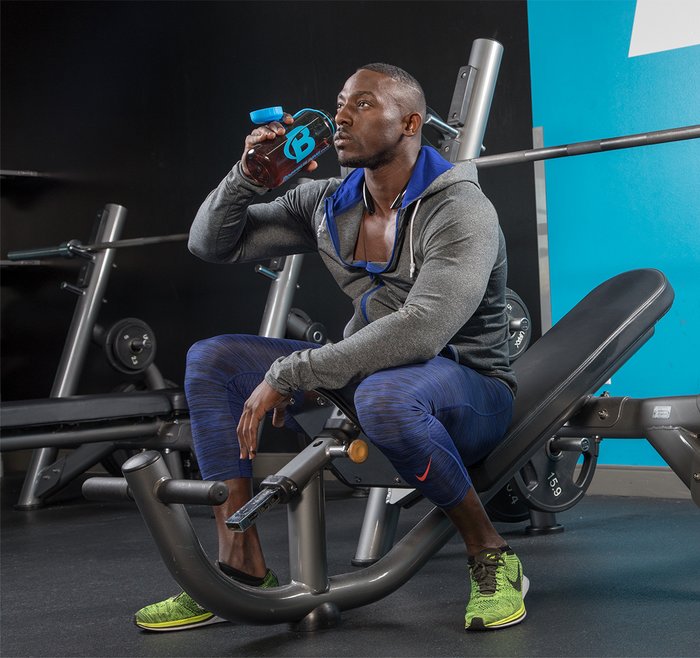To increase your bench press—or reach any life goal—you first need to figure out a plan to lead you to that goal in the most efficient way. As Farr puts it, a lack of a plan will, at best, give you "random results through random action."
Quality and Quantity
As Farr points out, shooting 100 free throws in one day will not make you Steph Curry—but shooting 100 free throws every day could. With their handy whiteboard, Silent Mike and Alan Thrall show us how performing the bench press only one day a week—despite it being a heavy 5 sets of 5 reps—is only 25 reps.
"In my opinion," Farr says, "you'll be better off practicing the technique of benching more often, allowing you to gather more volume and do those sets more perfectly because you're fresh."

Sure, switching to two days a week of 3 sets of 5 reps only increases your total reps by one set. But Mike notes that each of those reps will be better because you've reduced the volume on the workout. Your muscles are not as fatigued by the end, and your reps are cleaner and more precise. Yes, frequency is key, but so is quality. The better and more frequent your reps, the greater your total gains.
Practice, Practice, Practice
As Farr explains, practicing a movement alone—a process called "skill acquisition"—is an easy way to lift more volume, build more strength, and ultimately add more weight to your lifts.
The easiest way to up your volume—and your practice—is by adding 5-8 sets of 1-3 reps using a lighter weight. This can add an additional 24 reps, almost an entire extra day of bench pressing, to your weekly training volume. Doing so should improve your technique and ultimately build better strength.
The sweet spot for bench-press frequency tends to be 2-4 sessions per week. But you can always add lighter-weight practice sets to your existing routine. Many other factors influence muscle and strength gain, including recovery, nutrition, hydration, technique, overall strength, and even genetics. Keep tweaking your programing until you find the right combination of intensity and frequency for you.
Select Smart Variations
If you're already an experienced lifter benching two or three times per week and you've arrived at a plateau, there's still a lot you can do to transcend it. The magic formula for increasing strength as an intermediate or experienced lifter is to perform exercise variations.
As a novice lifter, you benefit from simply increasing frequency. After all, your body is still learning the skill. You don't really need variations—yet. You get a greater strength benefit from the extra practice, and frequent repetitions improve your technique.
As an experienced lifter, however, it is much more difficult to get the same muscular response by increasing frequency alone. Enter exercise variations. As Thrall explains, consider several factors when selecting an exercise variation:
- Movements using the most amount of muscle
- Movements allowing you to use the greatest amount of weight
- Movements giving you the longest range of motion
Keeping these factors in mind, you can see why a paused bench press might be better for building strength than a cable cross-over. Sure, the cross-over gives you a greater range of motion, but the paused bench press beats it in both muscle recruitment and weight.
As with any sport-specific or exercise-specific training, variations should be based on the movement you're trying to improve, not just the muscle group you're trying to strengthen. This is another reason why the paused bench beats the cable cross: If you want to build up your bench press, select movements that mimic the bench press. Thrall offers a variety of bench-press variations—touch-and-go bench, pause bench, tempo bench, slingshot bench, feet-up bench—to get you started.
Balanced Recovery
Technique, progression, frequency, variations—none of these matter unless you can fully recover from your workouts. Beyond merely balancing rest days with workouts, take into account how your daily nutrition, sleep, and hydration affect your performance goals.
Nutrition plays an important role in recovery. To gain muscle, you have to be in a calorie surplus.

"I'm a big proponent of tracking your food," says Farr. "The best way to gain muscle and to gain strength is by increasing your calories through time."
Sleep is another important factor. Although ideal daily requirements vary by individual, Farr points out that as an adult, you need to find out for yourself what your body prefers. More sleep is often better. If you're uncertain, try adding a few hours to your sleep schedule and see what it does for your strength.
Hydration plays a larger role in strength than many people realize. Chugging water during exercise isn't enough—you have to drink plenty of water every day, throughout the day, to flush your system and keep your body hydrated. If you're not sure how much water you should be drinking, start with half your body weight in ounces, and increase as needed from there. Spread out your total water intake throughout the day, and maintain that habit on nontraining days as well.
"Don't view food and sleep as a privilege," warns Thrall. Instead, view these factors as tools for creating better gains.
Farr concurs: "If you want to make serious gains, you have to be serious about your time outside of the gym."


